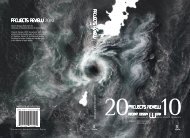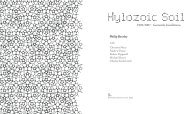The Inner Studio - Riverside Architectural Press
The Inner Studio - Riverside Architectural Press
The Inner Studio - Riverside Architectural Press
You also want an ePaper? Increase the reach of your titles
YUMPU automatically turns print PDFs into web optimized ePapers that Google loves.
PART FIVE | USING THIS LIFE TO BE CREATIVE AND WISE<br />
stuck on the tower and this was blocking every creative impulse.<br />
What had first inspired him had somehow drained the project of<br />
any creative juices. It was a mistake.<br />
Finally some creative sparks began to rise and the role of the<br />
tower began to drop right into its large public base. <strong>The</strong> project<br />
began to transform as the energy and desire that had been invested<br />
in one gesture started to infuse the entire project. A whirlwind of<br />
creative ideas broke through and the building started to come<br />
alive. In the end, you might say the tower had been necessary–it<br />
had a role to play in the design process–but not the role Frank had<br />
at first imagined. It showed Frank the implications of bringing a<br />
rigid approach to the act of design. It also showed him what a<br />
mistake felt like (it felt draining and depressing), and most importantly<br />
that he could survive his mistakes. He didn’t have to be<br />
afraid of letting them go. It is really helpful to know that you can<br />
learn from a mistake. Mistakes are among our most valuable teachers<br />
and will help move our design work forward if we can learn<br />
from them. <strong>The</strong> creative process loves paradox and so it is not<br />
unusual to find that you have to let go of what you have to get<br />
what you want.<br />
11. “I don’t have anything”/ “Nothing I try seems to work”<br />
I was sitting around a table with four students. It was a design<br />
seminar at the start of a large project. <strong>The</strong> students had been working<br />
on the assignment for two days. Each student was asked to<br />
show their work and then participate in a group discussion of their<br />
project. <strong>The</strong> first student, Marie, began by opening her sketchbook<br />
to a page that had three pencil drawings. <strong>The</strong> first was an idea for<br />
the spatial organization of the building. <strong>The</strong> second sketch was an<br />
idea for the vertical relationships showing a section through the<br />
building, and the final drawing was an interior sketch perspective<br />
of the major public space. She began by saying she didn’t have<br />
very much to show, and then she talked about her proposal for<br />
10 minutes, taking us through all of her ideas in considerable<br />
detail. She completed her presentation by apologizing for not<br />
having very much. She sounded indifferent and spoke without<br />
much confidence.<br />
159





